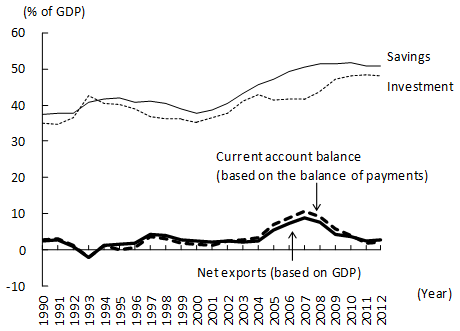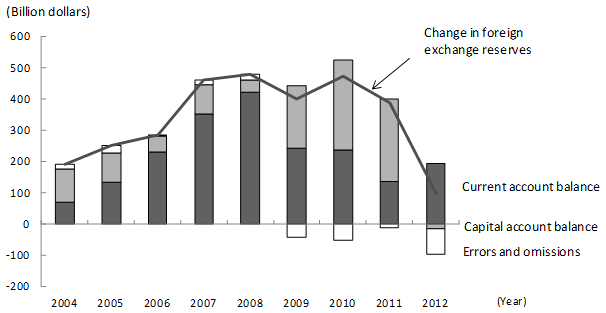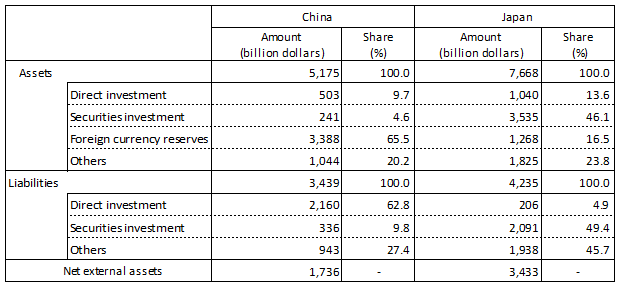China's net external assets have been increasing rapidly in recent years, reaching $1.74 trillion at the end of 2012, second only behind Japan, which had net external assets of $3.43 trillion. Given expected progress in the liberalization of capital transactions in China, "China money" will become an increasingly important factor that could influence major trends in international financial markets.
Sustained twin surpluses
The accumulation of net external assets is the direct result of a sustained surplus on the current account balance. The current account balance in turn is roughly equal to net exports, obtained by subtracting domestic investment from domestic savings on the basis of the gross domestic product (GDP) (Note 1). In China, the savings ratio (the ratio of savings to GDP) has consistently exceeded the investment ratio (the ratio of investment to GDP) since 1994. Reflecting this, the current account has been in surplus, with its ratio to GDP reaching its peak at 10.6% in 2007 (Figure 1).

Both the current account and the capital account have effectively been in surplus (Note 2). Driven by the accumulation of these twin surpluses, foreign exchange reserves have continued to increase (Figure 2). The amount of foreign exchange reserves reached $3.39 trillion at the end of 2012, surpassing that of Japan to become the largest in the world.

Structure of external assets and liabilities of China very different from that of Japan
Although both China and Japan are giant net creditor nations, the structure of external assets and liabilities of the former is very different from that of the latter, as noted below (Table 1).

First, on the asset side, securities investment by the private sector has a large share in Japan, while in China, foreign exchange reserves owned by the government are dominant. At the end of 2012, China had foreign exchange reserves of $3.39 trillion, which accounted for 65.5% of its external assets. Although direct investment and securities investment have been increasing in recent years, their levels are still low, accounting for only 9.7% and 4.6% of external assets, respectively. In contrast, securities investment makes up 46.1% of external assets in Japan, significantly topping the shares of foreign exchange reserves and direct investment, which are 16.5% and 13.6%, respectively.
Meanwhile, on the liability side, the share of securities investment is high in Japan, while that of direct investment is high in China. The inflow of direct investment has contributed significantly to China's economic development through not only capital provision but also technology transfer. At the end of 2012, inward direct investment amounted to $2.16 trillion, accounting for 62.8% of external liabilities of China and significantly exceeding securities investment, which made up 9.8%. On the other hand, in Japan, the share of securities investment was 49.4% of external liabilities, and that of inward direct investment was only 4.9%.
Improvement in return on investment is a challenge
From Table 1, the difference between the two countries in terms of the structure of external assets and liabilities is also noticeable in the following aspects. First, outward direct investment significantly exceeds inward direct investment in Japan, while the reverse is true in China. In addition, in securities investment, assets exceed liabilities in Japan, while liabilities exceed assets in China. Furthermore, although net external assets in China were only about half of those in Japan at the end of 2012, foreign exchange reserves in China were 2.7 times the level of Japan. The value of U.S. treasury bonds, the main investment vehicle for foreign exchange reserves, held by China reached $1.22 trillion, exceeding that of Japan ($1.11 trillion) (The U.S. Department of Treasury, Treasury International Capital System).
As such, China's external assets are concentrated on bonds, with a relatively low return on investment, mainly funded by foreign exchange reserves, while high-cost direct investment is the core part of external liabilities. Consequently, although China is a net creditor nation, it pays out more in investment income than it receives, resulting in a deficit of $57.4 billion in net return on investment in 2012. In fact, it is estimated that the rate of return on China's external assets was 3.0% in 2012, significantly below the rate of return on its liabilities of 6.6% (Note 3). China thus has an urgent need to improve the rate of return on investment by changing the structure of its external assets.
Expected changes in flow of funds as a result of capital account liberalization
The structure of external assets and liabilities in China that has caused this low rate of return reflects the fact that capital transactions are still severely restricted. However, this situation is likely to change significantly in the future as capital transactions become liberalized.
The Chinese government has cited the preparation of a concrete plan to advance the liberalization of capital transactions as one of the key points of the reform of its economic system in 2013 (a decision at the session of the Standing Committee of the State Council held on May 6, 2013). In that regard, a paper presented by a research team of the Research and Statistics Department of the People's Bank of China titled "Conditions for accelerating the liberalization of capital transactions of China have been almost put in place" (February 2012) will serve as the basis for discussion. This paper shows a roadmap with the three phases described below for liberalizing capital transactions over the next 10 years, taking the following conventional view on the order of liberalization: (1) capital inflow comes first, followed by capital outflow, (2) long-term transactions come first, followed by short-term transactions, (3) direct investment comes first, followed by indirect investment, and (4) institutional investors come first, followed by individual investors.
(1) Short-term target (1-3 years): Relax regulations on direct investment under the real demand principle and encourage outward direct investments by Chinese enterprises (Go Global, or "Zouchuqu" in Chinese).
(2) Medium-term target (3-5 years): Encourage deregulation of commercial loans related to international trade under the real demand principle and promote the internationalization of the Chinese renminbi.
(3) Long-term target (5-10 years): Liberalize capital outflows after liberalizing capital inflows, and gradually and carefully open investment in real estate, equities, and bond transactions to foreign capital.
If these proposals are realized, China's external assets will shift from foreign exchange reserves owned by the government to direct investment and securities investment by the private sector. In contrast to the dominance of inward direct investment observed in the past, it is expected that outward direct investment by Chinese companies will grow so that inward and outward direct investment will become more balanced. In addition, the securities market in China will become an important investment destination for foreign investors, and the presence of "China money" in international financial markets will also rise significantly.


